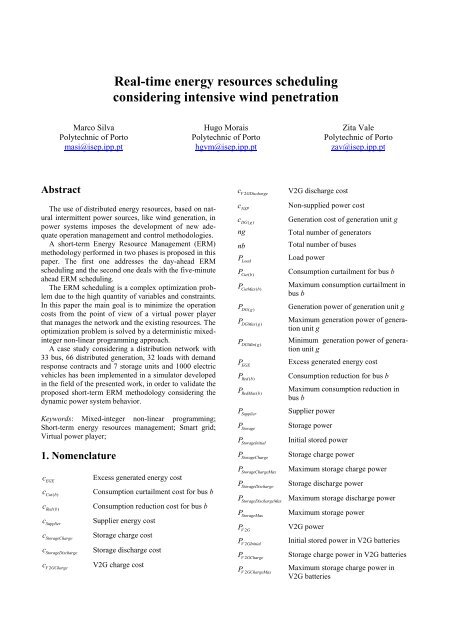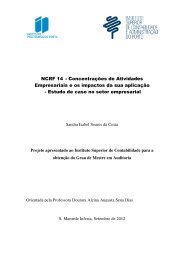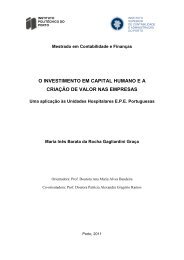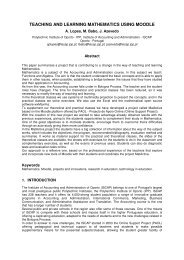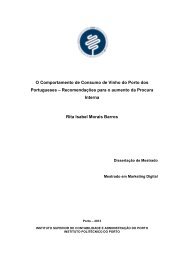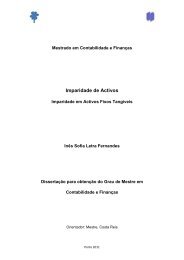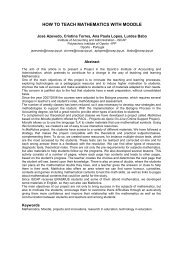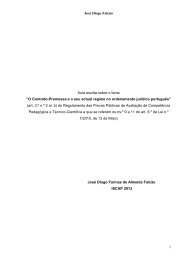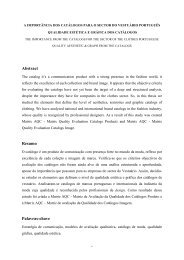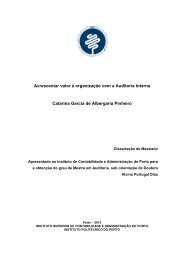Instructions for the preparation of a camera-ready paper in MS Word
Instructions for the preparation of a camera-ready paper in MS Word
Instructions for the preparation of a camera-ready paper in MS Word
- No tags were found...
Create successful ePaper yourself
Turn your PDF publications into a flip-book with our unique Google optimized e-Paper software.
Real-time energy resources schedul<strong>in</strong>gconsider<strong>in</strong>g <strong>in</strong>tensive w<strong>in</strong>d penetrationMarco SilvaPolytechnic <strong>of</strong> Portomasi@isep.ipp.ptHugo MoraisPolytechnic <strong>of</strong> Portohgvm@isep.ipp.ptZita ValePolytechnic <strong>of</strong> Portozav@isep.ipp.ptAbstractThe use <strong>of</strong> distributed energy resources, based on natural<strong>in</strong>termittent power sources, like w<strong>in</strong>d generation, <strong>in</strong>power systems imposes <strong>the</strong> development <strong>of</strong> new adequateoperation management and control methodologies.A short-term Energy Resource Management (ERM)methodology per<strong>for</strong>med <strong>in</strong> two phases is proposed <strong>in</strong> this<strong>paper</strong>. The first one addresses <strong>the</strong> day-ahead ERMschedul<strong>in</strong>g and <strong>the</strong> second one deals with <strong>the</strong> five-m<strong>in</strong>uteahead ERM schedul<strong>in</strong>g.The ERM schedul<strong>in</strong>g is a complex optimization problemdue to <strong>the</strong> high quantity <strong>of</strong> variables and constra<strong>in</strong>ts.In this <strong>paper</strong> <strong>the</strong> ma<strong>in</strong> goal is to m<strong>in</strong>imize <strong>the</strong> operationcosts from <strong>the</strong> po<strong>in</strong>t <strong>of</strong> view <strong>of</strong> a virtual power playerthat manages <strong>the</strong> network and <strong>the</strong> exist<strong>in</strong>g resources. Theoptimization problem is solved by a determ<strong>in</strong>istic mixed<strong>in</strong>tegernon-l<strong>in</strong>ear programm<strong>in</strong>g approach.A case study consider<strong>in</strong>g a distribution network with33 bus, 66 distributed generation, 32 loads with demandresponse contracts and 7 storage units and 1000 electricvehicles has been implemented <strong>in</strong> a simulator developed<strong>in</strong> <strong>the</strong> field <strong>of</strong> <strong>the</strong> presented work, <strong>in</strong> order to validate <strong>the</strong>proposed short-term ERM methodology consider<strong>in</strong>g <strong>the</strong>dynamic power system behavior.Keywords: Mixed-<strong>in</strong>teger non-l<strong>in</strong>ear programm<strong>in</strong>g;Short-term energy resources management; Smart grid;Virtual power player;1. Nomenclaturec Excess generated energy costEGEcCut ( b)Consumption curtailment cost <strong>for</strong> bus bcRed ( b)Consumption reduction cost <strong>for</strong> bus bcSupplierSupplier energy costcStorageChargeStorage charge costcStorageDischargeStorage discharge costcV 2GChargeV2G charge costcV 2GDischargeV2G discharge costc Non-supplied power costNSPcDG( g)Generation cost <strong>of</strong> generation unit gngTotal number <strong>of</strong> generatorsnbTotal number <strong>of</strong> busesP Load powerLoadPCut ( b)Consumption curtailment <strong>for</strong> bus bP Maximum consumption curtailment <strong>in</strong>CutMax ( b)bus bPDG ( g)PDGMax ( g)PDGM<strong>in</strong> ( g)PEGEPRed ( b)PRedMax ( b)Generation power <strong>of</strong> generation unit gMaximum generation power <strong>of</strong> generationunit gM<strong>in</strong>imum generation power <strong>of</strong> generationunit gExcess generated energy costPSupplierSupplier powerPStorageStorage powerConsumption reduction <strong>for</strong> bus bMaximum consumption reduction <strong>in</strong>bus bPStorageInitialInitial stored powerPStorageChargeStorage charge powerPStorageChargeMaxMaximum storage charge powerPStorageDischargeStorage discharge powerPStorageDischargeMaxMaximum storage discharge powerPStorageMaxMaximum storage powerP V2G powerV2GP Initial stored power <strong>in</strong> V2G batteriesV 2GInitialPV 2GChargeStorage charge power <strong>in</strong> V2G batteries2 V GChargeMaxP Maximum storage charge power <strong>in</strong>V2G batteries
P Storage discharge power <strong>in</strong> V2G batteriesV 2GDischargeP Maximum storage discharge power <strong>in</strong>V 2GDischargeMaxV2G batteriesP Maximum storage power <strong>in</strong> V2G batteriesV 2GMaxP Non-supplied powerNSPX B<strong>in</strong>ary variable <strong>for</strong> consumption curtailment,<strong>for</strong> busCut ( b)bXDG( g)XStorageB<strong>in</strong>ary variable <strong>for</strong> generation unit gB<strong>in</strong>ary variable <strong>for</strong> storage chargeYStorage B<strong>in</strong>ary variable <strong>for</strong> storage dischargeXV2GB<strong>in</strong>ary variable <strong>for</strong> V2G chargeYV2GB<strong>in</strong>ary variable <strong>for</strong> V2G discharge1. IntroductionThe <strong>in</strong>creas<strong>in</strong>g use <strong>of</strong> Distributed Generation (DG),ma<strong>in</strong>ly based on renewable energy resources, and o<strong>the</strong>rDistributed Energy Resources (DER), <strong>in</strong>clud<strong>in</strong>g DG,Demand Response (DR) programs, storage systems andelectric and plug-<strong>in</strong> hybrid vehicles poses new challengesto Power Systems plann<strong>in</strong>g and operation. Also <strong>the</strong><strong>in</strong>troduction <strong>of</strong> liberalized markets <strong>in</strong> <strong>the</strong> electricity sectorhas caused significant changes <strong>in</strong> power systemsagents relationships. DER use <strong>in</strong> distribution network hasbeen <strong>in</strong>creased significantly [1, 2], br<strong>in</strong>g<strong>in</strong>g new challengesto power systems agents and lead<strong>in</strong>g to <strong>the</strong> smartgrid concept [3-8].In some cases, <strong>the</strong> <strong>in</strong>vestment made <strong>in</strong> RES is not used<strong>in</strong> its full extent. In some periods, with high w<strong>in</strong>d generationand low demand consumption, a w<strong>in</strong>d curtailment isalso necessary. Presently, operation plann<strong>in</strong>g methodsare not adequate to <strong>the</strong> characteristics <strong>of</strong> most <strong>of</strong> DERand even with a lot <strong>of</strong> ongo<strong>in</strong>g research work some problemsrema<strong>in</strong> unsolved. This is <strong>the</strong> case <strong>of</strong> real-time DERmanagement which should take <strong>in</strong>to account all <strong>the</strong> relevanttechnical and economic issues [9, 10].The high number <strong>of</strong> w<strong>in</strong>d energy is worrisome, s<strong>in</strong>cew<strong>in</strong>d power is stochastic, especially <strong>in</strong> <strong>the</strong> very shortterm (e.g., over any given hour, 30 m<strong>in</strong>utes, 15 m<strong>in</strong>utesor 5 m<strong>in</strong>utes period) [11]. This has created a completelynew challenge to <strong>the</strong> system operators so ma<strong>in</strong>ta<strong>in</strong> cont<strong>in</strong>uouslybalance electricity supply and demand.The ma<strong>in</strong> difficulties with renewable energy resourcesare <strong>the</strong> dispatchability and reliability problems associatedwith <strong>the</strong>ir operation. The output <strong>of</strong> some renewable generation,such as w<strong>in</strong>d generators and photovoltaic systems,is determ<strong>in</strong>ed by <strong>the</strong> climate and wea<strong>the</strong>r conditionsand operat<strong>in</strong>g patterns will <strong>the</strong>re<strong>for</strong>e follow <strong>the</strong>senatural conditions. The <strong>in</strong>termittent nature <strong>of</strong> <strong>the</strong>sesources leads to an output which <strong>of</strong>ten does not suit <strong>the</strong>load demand pr<strong>of</strong>ile. Smart grids <strong>in</strong>troduce new managementconcepts with new operation methods <strong>for</strong> adequatelyschedul<strong>in</strong>g renewable based generation and allDER.Storage systems and electric vehicles could be veryuseful <strong>in</strong> <strong>the</strong> Energy Resources Management (ERM)process. These units <strong>in</strong>crease <strong>the</strong> consumption <strong>in</strong> generationsurplus cases (charge batteries) and <strong>in</strong>crease <strong>the</strong>generation <strong>in</strong> shortage generation cases (discharge batteries).Demand response programs can be used <strong>in</strong> a moreflexible way guarantee<strong>in</strong>g that <strong>the</strong> most costly generationresources are managed so that operation costs are keptwith<strong>in</strong> acceptable limits [12, 13]. The new context <strong>in</strong>cludesa large number <strong>of</strong> players (electricity consumers,DG owners, aggregat<strong>in</strong>g entities such as Virtual PowerPlayers (VPP) [14-16], and system operators) act<strong>in</strong>g <strong>in</strong>competitive Electricity Markets.Short-Term energy resource management is a veryrelevant task <strong>in</strong> modern energy systems [9, 10]. It consists<strong>in</strong> correctly schedul<strong>in</strong>g <strong>the</strong> available DER <strong>in</strong> orderto reduce <strong>the</strong> operation costs. The number <strong>of</strong> variablesconsidered <strong>in</strong> this approaches, and <strong>the</strong> need <strong>for</strong> obta<strong>in</strong><strong>in</strong>ga rapid response, requires <strong>the</strong> usage <strong>of</strong> advanced optimizationtechniques, such as artificial <strong>in</strong>telligence techniques,namely metaheuristics such as Particle SwarmOptimization, Genetic Algorithms or Simulated Anneal<strong>in</strong>g[7, 9, 17-20].The coord<strong>in</strong>ation <strong>of</strong> all <strong>the</strong>se resources is a quite challeng<strong>in</strong>gissue requir<strong>in</strong>g distributed <strong>in</strong>telligence accord<strong>in</strong>gto <strong>the</strong> concept <strong>of</strong> <strong>the</strong> smart grid [3, 6, 8]. This can beachieved through an <strong>in</strong>tegration <strong>of</strong> <strong>the</strong> behavior and actions<strong>of</strong> all users connected to it, and so, adequatelyschedul<strong>in</strong>g renewable based generation and all DER,<strong>in</strong>clud<strong>in</strong>g <strong>the</strong> available load curtailment opportunities [1,10].This work contributes to overcome this situation conceiv<strong>in</strong>g,develop<strong>in</strong>g and implement<strong>in</strong>g methodologiesadequate <strong>for</strong> energy resource management <strong>in</strong> a distributionnetwork, consider<strong>in</strong>g <strong>in</strong>tensive penetration <strong>of</strong> DG,storage, electric vehicles and load curtailment opportunitiesenabled by demand response programs <strong>in</strong> <strong>the</strong> context<strong>of</strong> future power systems. The proposed methodologiesare based on <strong>the</strong> characteristics <strong>of</strong> <strong>the</strong> problem and <strong>of</strong> <strong>the</strong><strong>in</strong>volved resources.2. Energy Resource ManagementMethodologyProper use <strong>of</strong> optimization techniques <strong>in</strong> <strong>the</strong> DERreal-time schedul<strong>in</strong>g is very relevant <strong>for</strong> smart grids.This is ma<strong>in</strong>ly due to <strong>the</strong> lack <strong>of</strong> accuracy <strong>in</strong> w<strong>in</strong>d <strong>for</strong>ecast<strong>in</strong>gwhen <strong>the</strong> <strong>for</strong>ecast<strong>in</strong>g anticipation is <strong>in</strong>creased. In[21] <strong>the</strong> authors demonstrate that w<strong>in</strong>d <strong>for</strong>ecast<strong>in</strong>g can bevery accurate <strong>for</strong> very short-term <strong>for</strong>ecast<strong>in</strong>g, us<strong>in</strong>g <strong>the</strong>last 5 hours <strong>of</strong> w<strong>in</strong>d speed data to predict <strong>the</strong> next 5m<strong>in</strong>utes. This methodology can be used <strong>in</strong> this case toupdate 5 m<strong>in</strong>utes ahead optimization <strong>in</strong>put data. In [22]very short-term w<strong>in</strong>d <strong>for</strong>ecast<strong>in</strong>g is also discussed <strong>for</strong> areal world application us<strong>in</strong>g data provided by HydroTasmania. A 2.5 m<strong>in</strong>utes horizon is proposed <strong>in</strong> <strong>the</strong> usedneuro-fuzzy methodology with less than 4% error. How-
ever, <strong>the</strong> <strong>for</strong>ecast accuracy significantly drops when <strong>the</strong>time horizon is extended, with much higher errors when<strong>the</strong> prediction is made several hours ahead, namely <strong>for</strong>medium-term <strong>for</strong>ecast<strong>in</strong>g, with over 6 hours <strong>of</strong> anticipation.Due to <strong>the</strong> difficulties <strong>of</strong> hav<strong>in</strong>g accurate <strong>for</strong>ecast<strong>in</strong>g<strong>for</strong> natural resources, ma<strong>in</strong>ly due to <strong>for</strong>ecast w<strong>in</strong>d, <strong>the</strong>schedul<strong>in</strong>g <strong>of</strong> energy resources should be undertakenwith little anticipation. This leads to <strong>the</strong> proposal <strong>of</strong> atwo-phase short-term energy resources schedul<strong>in</strong>g, withdifferent time anticipations (1 hour and 5 m<strong>in</strong>) (Figure 1),each one consider<strong>in</strong>g <strong>the</strong> most updated <strong>for</strong>ecasts, <strong>the</strong>al<strong>ready</strong> established contracts and market transactions and<strong>the</strong> market opportunities. The authors propose a newmethodology to <strong>the</strong> real-time energy resource managementthat considers all <strong>the</strong> referred resources and aims atm<strong>in</strong>imiz<strong>in</strong>g <strong>the</strong> operation costs. The developed methodologyconsiders two different algorithms. The first one isused <strong>in</strong> each hour and <strong>the</strong> objective function consists <strong>in</strong>m<strong>in</strong>imiz<strong>in</strong>g <strong>the</strong> operation cost. The difference between<strong>the</strong> energy resource schedul<strong>in</strong>g computed <strong>in</strong> <strong>the</strong> previousday and <strong>the</strong> energy resource schedul<strong>in</strong>g necessary to respondto <strong>the</strong> <strong>for</strong>ecasted load demand. The second one isrun <strong>in</strong> real-time <strong>for</strong> each period <strong>of</strong> 5 m<strong>in</strong>utes [23]. It considers<strong>the</strong> adjustment accord<strong>in</strong>g to <strong>the</strong> <strong>for</strong>ecast <strong>of</strong> generationto <strong>the</strong> verified load demand. The difference betweenalgorithms concerns <strong>the</strong> resources managed by each one.All <strong>the</strong> resources (generators, storage units, electric vehicles,demand response programs, and <strong>the</strong> <strong>in</strong>tra-day market)are considered by <strong>the</strong> first algorithm. The secondalgorithm (5 m<strong>in</strong>utes) only manages <strong>the</strong> connected generators(sp<strong>in</strong>n<strong>in</strong>g reserve) with available power capacity,storage units, electric vehicles, demand response withload reduction contracts, and considers market penalties.The ma<strong>in</strong> goal is m<strong>in</strong>imize <strong>the</strong> operation cost and m<strong>in</strong>imize<strong>the</strong> impact <strong>in</strong> <strong>the</strong> day ahead and hour ahead energyresources schedul<strong>in</strong>g. Consider<strong>in</strong>g <strong>the</strong>se goals <strong>the</strong> aggregatorreduces <strong>the</strong> operation costs and at same time <strong>the</strong>market penalties.To test <strong>the</strong> methodology, a distribution network hasbeen implemented <strong>in</strong> an Power Systems Simulation Tool(PSST) [24]. In each period <strong>of</strong> optimization, PSST exports<strong>the</strong> <strong>in</strong>stant data (bus voltages, generation, load consumptions,l<strong>in</strong>e power flows, etc) to optimization tools<strong>of</strong>tware (OTS). The <strong>in</strong>puts to <strong>the</strong> algorithms <strong>of</strong> optimizationare <strong>the</strong> actual data <strong>of</strong> generation and consumptionsent by PSST and existent data base with equipmentcharacteristics, DR contracts, and day-ahead electricitymarket <strong>in</strong><strong>for</strong>mation.Fig. 1. Proposed methodology architecture
2.1. Ma<strong>the</strong>matical <strong>for</strong>mulationThis sub-section presents <strong>the</strong> ma<strong>the</strong>matical <strong>for</strong>mulation<strong>of</strong> <strong>the</strong> problem proposed to be solved. This problemis classified as mixed-<strong>in</strong>teger non-l<strong>in</strong>ear. The objectivefunction (1) <strong>of</strong> this mixed-<strong>in</strong>teger non-l<strong>in</strong>ear model is<strong>for</strong>mulated with <strong>the</strong> aim <strong>of</strong> f<strong>in</strong>d<strong>in</strong>g <strong>the</strong> m<strong>in</strong>imal cost <strong>of</strong>supply<strong>in</strong>g <strong>the</strong> demand.M<strong>in</strong>imizengPSupplier cSupplier ( PDG ( g ) cDG( g )) g 1PStorageChargecStorageChargePStorageDischargecStorageDischargef PV 2GCharge cV 2GChargePV 2GDischarge cV 2GDischargePNSP cNSP PEGE cEGE nb PCut( b) cCut( b) b1 PRed ( b) c Red ( b)Two demand response capacities (consumption reductionand consumption curtailment) are considered as aresource. The existence <strong>of</strong> storage units and several generators,as well as <strong>the</strong> energy supplied by a supplier, arealso considered.Equations (2) to (13) refer to <strong>the</strong> constra<strong>in</strong>ts that areconsidered. Equation (2) refers to <strong>the</strong> first Kirchh<strong>of</strong>f Lawor power balance constra<strong>in</strong>t.ngP P P PSupplier DG( g) StorageDischarge V 2GDischargeg 1nb P P PNSP Cut( b) Red ( b)b1 P P P PLoad StorageCharge V 2GCharge EGEEquations (3) to (7) represent <strong>the</strong> constra<strong>in</strong>ts concern<strong>in</strong>g<strong>the</strong> maximum capacity consider<strong>in</strong>g <strong>the</strong> available resources,<strong>for</strong> both generation (3, 4) and load response (5,6), and <strong>for</strong> storage units (7). In <strong>the</strong> consumption curtailmentprogram, <strong>the</strong> participation <strong>of</strong> each load only can beby its total curtailment power.P P(3)DG( g) DGMax ( g)DG( g) DGM<strong>in</strong> ( g) DG( g) DG( g)(2)P P X ; X 0,1 (4)P P X ; X 0,1(5)Cut ( b) Cut ( b) Cut ( b) CutA( b)P P(6)Red ( b) RedMax ( b)(1)considered <strong>in</strong> equation (8) and <strong>the</strong> charge capacity <strong>in</strong>equation (9). In each <strong>in</strong>stant, <strong>the</strong> battery only can becharg<strong>in</strong>g or discharg<strong>in</strong>g, as imposed <strong>in</strong> equation (10).P P X ; X 0,1StorageDischarge StorageDischargeMax Storage StorageP P Y ; Y 0,1 (9)StorageCharge StorageChargeMax Storage StorageX Y 1; X and Y 0,1 (10)Storage Storage Storage StorageIt is also necessary to impose that it is not possible todischarge more than <strong>the</strong> stored energy (11). Similarly,<strong>the</strong> power to be charged plus <strong>the</strong> power stored cannot behigher than <strong>the</strong> total storage resource capacity (12). F<strong>in</strong>ally,<strong>the</strong> storage state is obta<strong>in</strong>ed consider<strong>in</strong>g <strong>the</strong> <strong>in</strong>itialstored energy, <strong>the</strong> charge, and <strong>the</strong> discharge <strong>in</strong> each timeperiod (13).PStorageDischargeP 0(11)StorageInitialPStorageCharge PStorageInitial PStorageMax(12)PStorage PStorageInitial PStorageDischarge PStorageCharge(13)Electric vehicles with gridable capability (V2G) resourcesrequire a special treatment due to specific operationconstra<strong>in</strong>ts. The discharge capacity is considered <strong>in</strong>equation (14) and <strong>the</strong> charge capacity <strong>in</strong> equation (15). Ineach <strong>in</strong>stant, <strong>the</strong> battery only can be charg<strong>in</strong>g or discharg<strong>in</strong>g,as imposed <strong>in</strong> equation (16).P P X ; X 0,1 (14)V 2GDischarge V 2GDischargeMax V 2G V 2GP P Y ; Y 0,1 (15)V 2GCharge V 2GChargeMax V 2G V 2GX Y 1; X and Y 0,1 (16)V 2G V 2G V 2G V 2GIt is also necessary to impose that it is not possible todischarge more than <strong>the</strong> stored energy (17). Similarly,<strong>the</strong> power to be charged plus <strong>the</strong> power stored cannot behigher than <strong>the</strong> total storage resource capacity (18). F<strong>in</strong>ally,<strong>the</strong> storage state is obta<strong>in</strong>ed consider<strong>in</strong>g <strong>the</strong> <strong>in</strong>itialstored energy, <strong>the</strong> charge, and <strong>the</strong> discharge <strong>in</strong> each timeperiod (19).PV 2GDischargePV 2GInitial0 (17)P P P(18)V 2GCharge V 2G V 2GMaxP P P P(19)V 2G V 2GInitial V 2GDischarge V 2GCharge(8)PStorage P(7)StorageMaxStorage resources require a special treatment due tospecific operation constra<strong>in</strong>ts. The discharge capacity is
2.2. Short-term schedul<strong>in</strong>g simulatorIn this work <strong>the</strong> DICOPT solver is used to <strong>the</strong> MINLPapproach <strong>for</strong> <strong>the</strong> short-term energy resources management,<strong>the</strong> OTS is used <strong>for</strong> <strong>in</strong>terface between <strong>the</strong> results<strong>of</strong> schedul<strong>in</strong>g and <strong>the</strong> simulation tool [28-30]. To simulate<strong>the</strong> use <strong>of</strong> DER <strong>in</strong> power systems, it is necessary tocreate models <strong>in</strong> simulation tools to test schedul<strong>in</strong>g solutionsprior to actual implementation. The tool <strong>for</strong> simulation<strong>of</strong> electricity network and energy resources used toapply <strong>the</strong> proposed methodology is PSST.The choice <strong>of</strong> <strong>the</strong>se three s<strong>of</strong>tware packages fulfilled<strong>the</strong> requirements, provid<strong>in</strong>g us with powerful ma<strong>the</strong>maticalresources <strong>of</strong> DICOPT solver, and <strong>the</strong> use <strong>of</strong> <strong>the</strong> OTSwith <strong>the</strong> advantage <strong>of</strong> an efficient connection with <strong>the</strong>PSST power system simulator. This tool allows buildcustom models us<strong>in</strong>g PSST Design Editor. PSST hasbeen widely used <strong>in</strong> <strong>the</strong> study <strong>of</strong> distributed energy resources[31-37].To simulate <strong>the</strong> distribution network <strong>for</strong> <strong>the</strong> hourlyoperation plann<strong>in</strong>g, <strong>the</strong> authors had to implement <strong>the</strong>network <strong>in</strong> PSST and to create models <strong>of</strong> distributedgeneration units, loads, l<strong>in</strong>es and substation. Dur<strong>in</strong>g <strong>the</strong>simulation, PSST receives <strong>in</strong><strong>for</strong>mation concern<strong>in</strong>g distributionnetwork data, network state, DG and DR shorttermschedul<strong>in</strong>g result<strong>in</strong>g from <strong>the</strong> optimization process.The optimization process, needs <strong>the</strong> follow<strong>in</strong>g data: generationdata, generation costs, DR contracts, day-aheadDER schedul<strong>in</strong>g and <strong>the</strong> <strong>in</strong>tra-day market price, with <strong>the</strong>objective to m<strong>in</strong>imize <strong>the</strong> cost <strong>of</strong> <strong>the</strong> DG, load curtailmentand <strong>the</strong> <strong>in</strong>tra-day market.PSST has <strong>the</strong> capability <strong>of</strong> <strong>in</strong>terfac<strong>in</strong>g with OTScommands and toolboxes through a special <strong>in</strong>terface.OTS programs or block-sets that are to be <strong>in</strong>terfacedwith PSST must be designed and saved as an OTS programfile. Then, a user-def<strong>in</strong>ed block must be provided<strong>in</strong> PSST, with <strong>the</strong> necessary <strong>in</strong>puts and outputs, to <strong>in</strong>terface<strong>the</strong> OTS file. In this <strong>paper</strong>, an <strong>in</strong>terfac<strong>in</strong>g block hasbeen created <strong>in</strong> PSST to l<strong>in</strong>k <strong>the</strong> OTS files def<strong>in</strong>ed with<strong>in</strong><strong>the</strong> block.Fig. 2 shows components and <strong>the</strong> connection between<strong>the</strong> PSST and OTS.Fig. 2. Components and connections <strong>of</strong> a bus implemented<strong>in</strong> PSSTwhere:pgnqgnvivjplkqlkpijxqijxpjixqjixfckIfgnfgnActive power <strong>of</strong> DG unit n <strong>in</strong> BUS iReactive power <strong>of</strong> DG unit n <strong>in</strong> BUS iVoltage magnitude <strong>in</strong> BUS iVoltage magnitude <strong>in</strong> BUS jActive power demand <strong>of</strong> load k <strong>in</strong> BUS iReactive power demand <strong>of</strong> load k <strong>in</strong> BUS iActive power <strong>in</strong> l<strong>in</strong>e x from BUS i to BUS jReactive power <strong>in</strong> l<strong>in</strong>e x from BUS i to BUS jActive power <strong>in</strong> l<strong>in</strong>e x from BUS j to BUS iReactive power <strong>in</strong> l<strong>in</strong>e x from BUS j to BUS iLoad control variable <strong>of</strong> load kMax. <strong>in</strong>stantaneous active power generator <strong>of</strong>DG unit nGenerator control variable <strong>of</strong> DG unit nThe network values obta<strong>in</strong>ed <strong>for</strong> period t and withload <strong>for</strong>ecast and generation <strong>for</strong>ecast <strong>for</strong> period t+1, areimportant data <strong>for</strong> optimization process. The obta<strong>in</strong>edoptimized solution is sent to PSST, through <strong>the</strong> follow<strong>in</strong>gvariables: <strong>the</strong> load control variable <strong>in</strong> each load, <strong>the</strong>maximum <strong>in</strong>stantaneous active power <strong>in</strong> each distributedgeneration unit, and <strong>the</strong> generator control variable <strong>in</strong>each distributed generation unit. These variables will set<strong>the</strong> new state <strong>of</strong> <strong>the</strong> generators and loads.4. Case studyThe case study shows <strong>the</strong> simulation <strong>of</strong> a distributionnetwork with high DER penetration us<strong>in</strong>g PSST simulationtool and DICOPT solver to optimize <strong>the</strong> energy resourcesusage, and OTS to <strong>in</strong>terface between <strong>the</strong> optimizationand <strong>the</strong> simulation tool. The method considers <strong>the</strong>5 m<strong>in</strong>utes operation plann<strong>in</strong>g, <strong>in</strong> each phase, all <strong>the</strong>available resources (DG, demand response, electric vehiclesand storage) respect<strong>in</strong>g <strong>the</strong>ir technical limits, contracts,day-ahead and <strong>in</strong>tra-day schedul<strong>in</strong>g, and aims atm<strong>in</strong>imiz<strong>in</strong>g <strong>the</strong> VPP operation costs.The simulator will iterate with <strong>the</strong> optimization <strong>of</strong> <strong>the</strong>DER short-term schedul<strong>in</strong>g, <strong>in</strong> terms <strong>of</strong> <strong>the</strong> 5 m<strong>in</strong>utesoperation plann<strong>in</strong>g dur<strong>in</strong>g 2 hours scenario. The casestudy was implemented on <strong>the</strong> distribution network with33 buses, from [19, 25], with load and Distributed Generation(DG) evolution prediction <strong>for</strong> <strong>the</strong> year 2040 [26],with 32 load, 66 DG and 1000 electric vehicles, 7 storageand 10 external supplier [26]. The electric vehicles usescenarios were developed <strong>in</strong> EVeSSi Simulator tool. Thisapplication allows <strong>the</strong> creation <strong>of</strong> different scenariosconsider<strong>in</strong>g <strong>the</strong> trip parameters, electric vehicles classesand types parameters, and electric vehicles specific modelparameters [27].Short-term schedul<strong>in</strong>g is used to reschedule <strong>the</strong> previouslyobta<strong>in</strong>ed schedule tak<strong>in</strong>g advantage <strong>of</strong> <strong>the</strong> betteraccuracy <strong>of</strong> short-term <strong>for</strong>ecast<strong>in</strong>g <strong>in</strong> order to obta<strong>in</strong>more efficient resource schedul<strong>in</strong>g solutions.The used optimization is based on a MINLP approachthat has proved to achieve a satisfactory cost operat<strong>in</strong>gpo<strong>in</strong>t <strong>in</strong> a competitive time.The proposed methodology demonstrated to be able toprovide users with significant cost reductions, lower<strong>in</strong>g
<strong>the</strong> power losses and resource use costs. Moreover, it<strong>in</strong>cludes a dynamic analysis <strong>of</strong> <strong>the</strong> power system simulation,which is based on <strong>the</strong> use <strong>of</strong> PSST.Table 1 summarizes <strong>the</strong> considered energy resourcescosts <strong>for</strong> <strong>the</strong> case study and <strong>the</strong> number <strong>of</strong> DG units.Table 1. Case study energy resource data.Energy Resources Number <strong>of</strong> unitsPrice(m.u./MWh)case studyBiomass 4 0.0500 – 0.0720Cogeneration 15 0.0416 – 0.0600Fuel cell 7 0.5833 – 0.8400Hydro small 2 0.0458 – 0.0660Photovoltaic 31 0.0167 – 0.0240Waste to energy 1 0.0375 – 0.0540W<strong>in</strong>d 6 0.0250 – 0.0360Load DR 32 1.000 – 15.000Energy supply 10 0.5833 – 0.8400ElectricvehiclesDischarge 1000 0.2000 – 0.2500The results <strong>of</strong> loads consumption and <strong>the</strong> DG (PV andW<strong>in</strong>d) prediction can be seen <strong>in</strong> Fig. 3.The MINLP based optimization approach described <strong>in</strong>section 2 has been used <strong>for</strong> determ<strong>in</strong><strong>in</strong>g <strong>the</strong> DistributedGeneration and Demand Response short-term schedul<strong>in</strong>g<strong>for</strong> this case study. It is important to note that all 288optimizations, each one undertaken <strong>for</strong> 5 m<strong>in</strong>utes, aredependent from each o<strong>the</strong>r, because <strong>of</strong> <strong>the</strong> state <strong>of</strong> storageand state <strong>of</strong> electric vehicles. DER schedul<strong>in</strong>g <strong>for</strong>period t is undertaken <strong>in</strong> period t-1, consider<strong>in</strong>g <strong>the</strong> operationstate result<strong>in</strong>g from <strong>the</strong> schedule al<strong>ready</strong> used <strong>for</strong><strong>the</strong> previous periods.The methodology used to simulate <strong>the</strong> power system<strong>of</strong> this case study has been tested on a PC compatiblewith one Intel Xeon W5450 3.00 GHz processor, with 8Cores, 12GB <strong>of</strong> random-access-memory (RAM) andW<strong>in</strong>dows Sever Enterprise.4.2. Resultsschedul<strong>in</strong>g <strong>in</strong> <strong>the</strong> day-ahead and <strong>in</strong> <strong>the</strong> hour-ahead and<strong>the</strong> transients effects between <strong>the</strong> schedul<strong>in</strong>g periods. Inthis <strong>paper</strong> are presented <strong>the</strong> transient effects simulated <strong>in</strong>PSST.Figure 4 shows <strong>the</strong> results <strong>in</strong> PSST <strong>of</strong> an example <strong>of</strong><strong>the</strong> several energy resources evolution along a set <strong>of</strong> periods<strong>in</strong> bus 18. In Figure 5 is possible to see an example<strong>of</strong> <strong>the</strong> energy <strong>in</strong> a storage unit and an electric vehicle <strong>for</strong><strong>the</strong> same periods <strong>of</strong> time5. ConclusionsThis <strong>paper</strong> presented a short-term energy resourcemanagement methodology <strong>in</strong>volv<strong>in</strong>g day-ahead and fivem<strong>in</strong>utesahead schedul<strong>in</strong>g. Short-term schedul<strong>in</strong>g is usedto reschedule <strong>the</strong> previously obta<strong>in</strong>ed schedule tak<strong>in</strong>gadvantage <strong>of</strong> <strong>the</strong> better accuracy <strong>of</strong> short-term w<strong>in</strong>d andsolar generation and demand consumption <strong>for</strong>ecast<strong>in</strong>g <strong>in</strong>order to obta<strong>in</strong> more efficient resource schedul<strong>in</strong>gsolutions.The proposed method considers distributed generators,storage units, electric vehicles and two dist<strong>in</strong>ct demandresponse programs –consumption reduction and consumptioncurtailment.The optimization process use a determ<strong>in</strong>istic approachmixed <strong>in</strong>teger non-l<strong>in</strong>ear programm<strong>in</strong>g (MINLP). Theobta<strong>in</strong>ed feasibility solution is technically validatedus<strong>in</strong>g realistic power system simulation, based on PSST.The presented case study is based on a 33 busdistribution network with distributed generation, storageunits, electric vehicles and controllable loads.AcknowledgementsThis work is supported by FEDER Funds throughCOMPETE program and by National Funds throughFCT under <strong>the</strong> projects FCOMP-01-0124-FEDER:PEST-OE/EEI/UI0760/2011,PTDC/EEA-EEL/099832/2008, and PTDC/SEN-ENR/099844/2008.Several results can be obta<strong>in</strong>ed from <strong>the</strong> simulations <strong>in</strong>this case study. The most important ones are energyFig. 3. Load <strong>for</strong>ecast<strong>in</strong>g and <strong>the</strong> DG <strong>for</strong>ecast<strong>in</strong>g.
Fig. 4. Example <strong>of</strong> evolution <strong>of</strong> energy resources (EV – Electric Vehicle, S – Storage, PV – Photovoltaic, W – W<strong>in</strong>d,L – Load) and voltage (V)Electric vehicleout <strong>of</strong>f gridFig. 5. Example evolution <strong>of</strong> energy <strong>in</strong> a storage unit and <strong>in</strong> a electric vehicle batteries
References[1] H. Morais, P. Kadar, P. Faria, Z. A. Vale, and H. M. Khodr,"Optimal schedul<strong>in</strong>g <strong>of</strong> a renewable micro-grid <strong>in</strong> an isolatedload area us<strong>in</strong>g mixed-<strong>in</strong>teger l<strong>in</strong>ear programm<strong>in</strong>g," RenewableEnergy, vol. 35, pp. 151-156, Jan 2010.[2] H. M. Khodr, M. R. Silva, Z. Vale, and C. Ramos, "Aprobabilistic methodology <strong>for</strong> distributed generation location <strong>in</strong>isolated electrical service area," Electric Power Systems Research,vol. 80, pp. 390-399, Apr 2010.[3] IEEE. (2011, IEEE SMART GRID. Available:http://smartgrid.ieee.org/[4] Kim J<strong>in</strong>ho and Park Hong-Il, "Policy Directions <strong>for</strong> <strong>the</strong> SmartGrid <strong>in</strong> Korea," Power and Energy Magaz<strong>in</strong>e, IEEE, vol. 9, pp.40-49, 2011.[5] I. K. Song, K. D. Kim, J. Kelly, and C. Thomas, "Local GreenTeams," Ieee Power & Energy Magaz<strong>in</strong>e, vol. 9, pp. 66-74, Jan-Feb 2011.[6] Li Fangx<strong>in</strong>g, Qiao Wei, Sun Hongb<strong>in</strong>, Wan Hui, Wang Jianhui,Xia Yan, Xu Zhao, and Zhang Pei, "Smart Transmission Grid:Vision and Framework," Smart Grid, IEEE Transactions on, vol.1, pp. 168-177, 2010.[7] Z. A. Vale, P. Faria, H. Morais, H. M. Khodr, M. Silva, and P.Kadar, "Schedul<strong>in</strong>g Distributed Energy Resources <strong>in</strong> an isolatedgrid - An Artificial Neural Network Approach," Ieee Power andEnergy Society General Meet<strong>in</strong>g 2010, 2010.[8] European Commission, "European SmartGrids TechnologyPlat<strong>for</strong>m - Vision and Strategy <strong>for</strong> Europe’s Electricity Networks<strong>of</strong> <strong>the</strong> Future," E. Communities, Ed., ed, 2006.[9] M. Silva, H. Morais, and Z. A. Vale, "Distribution network shortterm schedul<strong>in</strong>g <strong>in</strong> Smart Grid context," <strong>in</strong> Power and EnergySociety General Meet<strong>in</strong>g, 2011 IEEE, 2011, pp. 1-8.[10] A. Borghetti, M. Bosetti, S. Grillo, S. Massucco, C. A. Nucci, M.Paolone, and F. Silvestro, "Short-Term Schedul<strong>in</strong>g and Control<strong>of</strong> Active Distribution Systems With High Penetration <strong>of</strong>Renewable Resources," Ieee Systems Journal, vol. 4, pp. 313-322,Sep 2010.[11] CEPOS, "W<strong>in</strong>d Energy - The case <strong>of</strong> Denmark," Center <strong>for</strong>Politiske Studier, Copenhagen, DenmarkSeptember 2009.[12] ISO/RTO Council, "North American Wholesale ElectricityDemand Response Program Comparison," 2011.[13] M. H. Albadi and E. F. El-Saadany, "A summary <strong>of</strong> demandresponse <strong>in</strong> electricity markets," Electric Power SystemsResearch, vol. 78, pp. 1989-1996, Nov 2008.[14] C. Kieny, B. Berseneff, N. Hadjsaid, Y. Besanger, and J. Maire,"On <strong>the</strong> concept and <strong>the</strong> <strong>in</strong>terest <strong>of</strong> Virtual Power plant: someresults from <strong>the</strong> European project FENIX," 2009 Ieee Power &Energy Society General Meet<strong>in</strong>g, Vols 1-8, pp. 1877-1882, 2009.[15] K. E. Bakari and W. L. Kl<strong>in</strong>g, "Virtual power plants: An answerto <strong>in</strong>creas<strong>in</strong>g distributed generation," <strong>in</strong> Innovative Smart GridTechnologies Conference Europe (ISGT Europe), 2010 IEEEPES, 2010, pp. 1-6.[16] D. Pudjianto, C. Ramsay, and G. Strbac, "Virtual power plant andsystem <strong>in</strong>tegration <strong>of</strong> distributed energy resources," IetRenewable Power Generation, vol. 1, pp. 10-16, Mar 2007.[17] M. R. Silva, Z. Vale, H. M. Khodr, C. Ramos, and J. M. Yusta,"Optimal Dispatch with Reactive Power Compensation byGenetic Algorithm," 2010 Ieee Pes Transmission andDistribution Conference and Exposition: Smart Solutions <strong>for</strong> aChang<strong>in</strong>g World, 2010.[18] Jizhong Zhu, Optimization <strong>of</strong> power system operation.Piscataway, N.J.: Wiley-IEEE ; Chichester : John Wiley[distributor], 2009.[19] P. Faria, Z. Vale, J. Soares, and J. Ferreira, "Demand ResponseManagement <strong>in</strong> Power Systems Us<strong>in</strong>g a Particle SwarmOptimization Approach," Intelligent Systems, IEEE, vol. PP, pp.1-1, 2011.[20] T. Sousa, H. Morais, Z. Vale, P. Faria, and J. Soares, "Intelligentenergy resource management consider<strong>in</strong>g vehicle-to-grid: Asimulated anneal<strong>in</strong>g approach," Accepted <strong>for</strong> Publication onIEEE Transaction on Smart Grid, Special Issue onTransportation Electrification and Vehicle-to-Grid Applications,2011.[21] Sérgio Ramos, João Soares, Zita Vale, and Hugo Morais, "AData M<strong>in</strong><strong>in</strong>g Based Methodology <strong>for</strong> W<strong>in</strong>d Forecast<strong>in</strong>g,"presented at <strong>the</strong> 16th International Conference on IntelligentSystem Applications to Power Systems (ISAP 2011), Crete,Greece, 2011.[22] C. W. Potter and M. Negnevitsky, "Very short-term w<strong>in</strong>d<strong>for</strong>ecast<strong>in</strong>g <strong>for</strong> Tasmanian power generation," Ieee Transactionson Power Systems, vol. 21, pp. 965-972, May 2006.[23] Cali<strong>for</strong>nia ISO, "Renewables Integration Market Vision &Roadmap Day-<strong>of</strong> Market," Initial Straw Proposal07/06/20112011.[24] PSCAD, "Applications <strong>of</strong> PSCAD / EMTDC," 2008.[25] M. E. Baran and F. F. Wu, "Network Reconfiguration <strong>in</strong>Distribution-Systems <strong>for</strong> Loss Reduction and Load Balanc<strong>in</strong>g,"Ieee Transactions on Power Delivery, vol. 4, pp. 1401-1407, Apr1989.[26] P. Faria, Z. A. Vale, and J. Ferreira, "Demsi — A demandresponse simulator <strong>in</strong> <strong>the</strong> context <strong>of</strong> <strong>in</strong>tensive use <strong>of</strong> distributedgeneration," <strong>in</strong> Systems Man and Cybernetics (SMC), 2010 IEEEInternational Conference on, 2010, pp. 2025-2032.[27] J. Soares, "Modified PSO <strong>for</strong> day-ahead distributed energyresources schedul<strong>in</strong>g <strong>in</strong>clud<strong>in</strong>g vehicle-to-grid," Master degree<strong>the</strong>sis, Polytechnic <strong>of</strong> Porto, Portugal, 2011.BiographiesMarco Silva received <strong>the</strong> BSc degree <strong>in</strong>Electrical Eng<strong>in</strong>eer<strong>in</strong>g from <strong>the</strong> PolytechnicInstitute <strong>of</strong> Porto (ISEP/IPP), Portugal <strong>in</strong>2007. Presently, he is an Assistant Researcherat GECAD – Knowledge Eng<strong>in</strong>eer<strong>in</strong>g andDecision-Support Research Center <strong>of</strong>ISEP/IPP. His current research activities arefocused on future electrical networks with<strong>in</strong>tensive use <strong>of</strong> distributed generation.Hugo Morais (M’11 S’08) received <strong>the</strong>BSc and Master degrees <strong>in</strong> Electrical Eng<strong>in</strong>eer<strong>in</strong>gfrom <strong>the</strong> Polytechnic Institute <strong>of</strong>Porto (ISEP/IPP), Portugal <strong>in</strong> 2005 and 2010respectively. He is a Researcher at GECAD –Knowledge Eng<strong>in</strong>eer<strong>in</strong>g and Decision-Support Research Center and a PhD student.His research <strong>in</strong>terests <strong>in</strong>clude smart grids,virtual power players, and electricity markets.Zita A. Vale (SM’10 M’93 S’86) is <strong>the</strong>director <strong>of</strong> <strong>the</strong> Knowledge Eng<strong>in</strong>eer<strong>in</strong>g andDecision Support Research Center (GECAD)and a pr<strong>of</strong>essor at <strong>the</strong> Polytechnic Institute <strong>of</strong>Porto.She received her diploma <strong>in</strong> Electrical Eng<strong>in</strong>eer<strong>in</strong>g<strong>in</strong> 1986 and her PhD <strong>in</strong> 1993, bothfrom University <strong>of</strong> Porto. Her ma<strong>in</strong> research<strong>in</strong>terests concern Artificial Intelligence (A.I.)applications to Power System operation andcontrol, Electricity Markets, DistributedGeneration, and Smart Grids.


